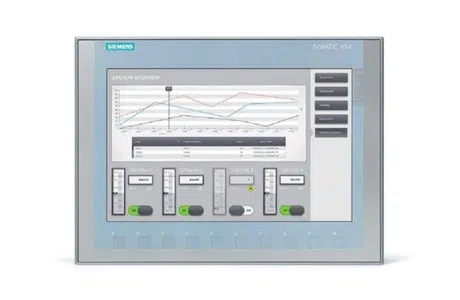How Do I Connect My Siemens HMI?
Key Takeaway
To connect a Siemens HMI, such as the TP700, to a Siemens PLC or other devices, you’ll typically use Ethernet or PROFIBUS communication protocols. These protocols ensure reliable data exchange between the HMI and the PLC, enabling real-time control and monitoring of industrial processes.
First, configure the communication settings on the Siemens HMI through TIA Portal, where you can define the network parameters. After setting up the HMI’s communication interface, you can physically connect it to the PLC via the appropriate cables. Once connected, the HMI can access and display the data from the PLC, allowing operators to interact with and control the system.
Connecting Siemens HMI to PLCs
Connecting Siemens HMI to Programmable Logic Controllers (PLCs) is a fundamental task in setting up an industrial automation system. This connection allows for seamless communication between the human interface and the control logic, enabling operators to monitor and manipulate manufacturing processes efficiently. Typically, this involves configuring communication protocols such as Profinet or Profibus, which are standard in Siemens automation environments.
The process of establishing this connection requires careful consideration of network architecture, addressing, and data exchange requirements. Siemens provides comprehensive guides and software tools within the TIA Portal to facilitate this setup, ensuring reliable and real-time data communication. Properly configured, this connection enhances system responsiveness and ensures that operators have accurate and timely information to make informed decisions, ultimately improving process control and productivity in industrial environments.

Required Hardware and Software for HMI Connections
Establishing effective HMI connections requires a combination of hardware and software components to ensure seamless communication between devices. The essential hardware typically includes a programmable logic controller (PLC), an HMI panel or touchscreen, and communication cables such as Ethernet or serial connections. These components create the physical link necessary for data transmission and user interaction.
On the software side, HMI connections rely on configuration and programming tools that enable the design and customization of interfaces. This software often includes drivers and protocols compatible with various PLC brands, ensuring interoperability between devices. Additionally, software tools facilitate the development of graphical user interfaces (GUIs), allowing operators to monitor and control processes efficiently.
Successful HMI connections demand careful selection and integration of both hardware and software elements, tailored to the specific needs of the application. By ensuring compatibility and proper configuration, engineers can establish reliable communication channels that enhance operational efficiency and provide real-time insights into industrial processes. This integration ultimately leads to improved decision-making, increased productivity, and optimized system performance.
You May Like to Read
Configuring Communication Settings in TIA Portal
Configuring communication settings in TIA Portal is a critical step in ensuring seamless integration and communication between devices in an industrial automation setup. TIA Portal, developed by Siemens, provides a comprehensive engineering framework for configuring and programming automation devices.
To configure communication settings, start by opening the TIA Portal and selecting the relevant project. Navigate to the device configuration section, where you can set network parameters such as IP addresses, subnet masks, and gateway addresses. Ensure that these parameters align with your network architecture to enable proper device communication.
Additionally, TIA Portal allows you to configure protocols like PROFINET or PROFIBUS, which are essential for communication in Siemens environments. Proper configuration of these settings ensures robust data exchange and system reliability. Documentation and support from Siemens can be invaluable if any issues arise during this process.
Troubleshooting Siemens HMI Connection Issues
Troubleshooting Siemens HMI connection issues requires a systematic approach. Initially, it’s essential to verify the physical connections, ensuring that cables are properly connected and that there are no visible signs of damage. Checking the power supply and ensuring that it meets the device’s specifications is also crucial.
Next, examining the network settings is vital. This includes verifying that the IP addresses are correctly configured and that the subnet masks align with the network requirements. Any discrepancies in these settings can prevent successful communication between the HMI and other devices.
Lastly, considering the software aspect is important. Ensuring that the correct drivers and firmware are installed and up-to-date can resolve many connection issues. Additionally, reviewing the HMI configuration settings within the software, such as communication protocols and port settings, can help identify any misconfigurations that might be causing connectivity problems.
Best Practices for Connecting Siemens HMI in Automation
Connecting Siemens HMI in automation involves following best practices to ensure efficient communication and integration with other system components. Firstly, it is crucial to choose the right HMI model that suits the specific needs of the application. Understanding the network requirements and configuring the HMI to match these specifications can prevent communication issues.
Properly setting up communication protocols is another essential step. Siemens HMIs support various protocols, such as PROFINET and PROFIBUS, which need to be configured correctly for seamless data exchange. Ensuring that all devices on the network are using compatible protocols will facilitate smooth communication.
Regular maintenance and updates are key to keeping the HMI system running optimally. This includes monitoring network performance, updating firmware, and implementing security measures to protect against cyber threats. By adhering to these best practices, users can maximize the efficiency and longevity of their Siemens HMI systems.
Conclusion
In conclusion, connecting a Siemens HMI involves several steps, including configuring the network settings and ensuring compatibility with the connected devices. Proper setup is crucial for seamless communication between the HMI and the control systems.
Following the manufacturer’s guidelines and utilizing appropriate software tools can significantly enhance the connectivity and functionality of the Siemens HMI, enabling efficient operation and monitoring.
